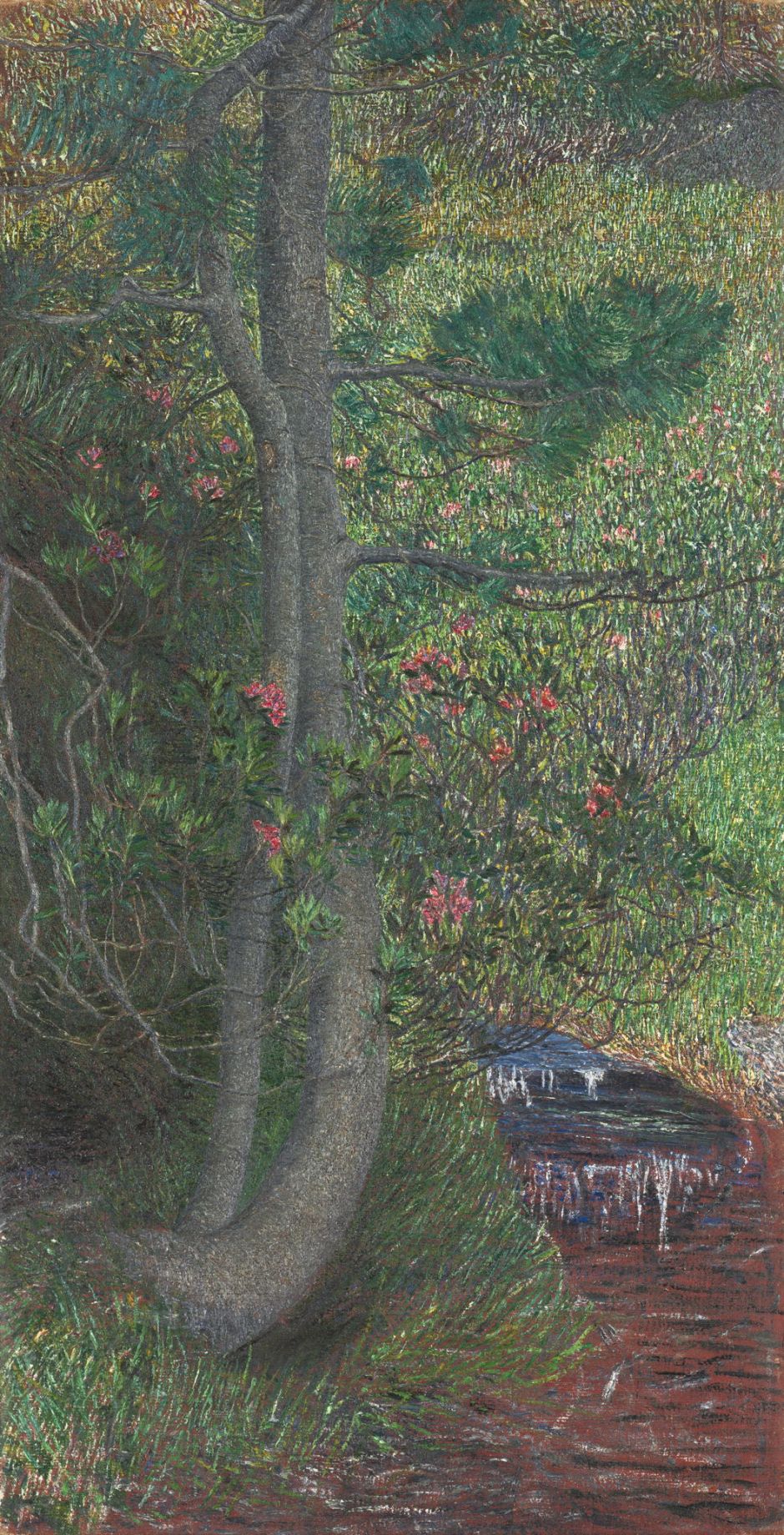In the first article about the Symbolist painting of Giovanni Segantini (1858–1899), I showed a selection of his paintings up to his first two overtly Symbolist works.
In the early 1890s, his relationship with the state was in deadlock: he was refused citizenship papers, so couldn’t marry his partner Bice or travel abroad, and he in turn refused to pay taxes. In 1894 he fled his tax bill and creditors, and moved to Engadine, where the family lived in a wood cabin at an altitude of nearly two thousand metres (6,200 feet). There he continued to paint Neo-Impressionist landscapes largely in front of the motif.

This mixed media study for The Angel of Life, painted in 1894, resulted in a finished oil painting commissioned for the villa of a banker. This shows the opposite aspects of motherhood from his previous Punishment of Lust and Bad Mothers, and its complementary painting is Fruit of Love, the finished oil version of which is shown below.
These secular madonnas embrace their infants with deep maternal love. Although their position, sat in the bough of a tree, may appear strange, it echoes those of the Bad Mothers, and is a longstanding motif which this artist had first used in 1881, in his Landscape with a Woman on a Tree. The overall effect shows influence from the Pre-Raphaelites and Art Nouveau. Although still set in Alpine landscapes, in these two paintings it is summer and the land is clear of frigid snow.


Returning Home from 1895 is based on Segantini’s personal experience of a family taking the body of their son home on a cart. He recasts the story to that of parents recovering their dead son from a foreign place, where he had fallen on misfortune. The landscape is that of Maloja in the Engadine, where the artist was then living, the village church being visible to the left.

Segantini painted Love at the Fountain of Life in 1896 apparently as a commission for Prince Yusupov of Saint Petersburg. Writing to a friend, Segantini explains it as showing the carefree love of a woman, and the more contemplative love of a man (an interesting reversal), who are walking along a narrow path surrounded by the spring flowers of the alpenrose or rhododendron.
The couple’s white clothes represent lilies; red rhododendrons represent everlasting love; the pine represents eternal hope. A distrustful angel spreads its wings over the Fountain of Life, where water bubbles from rock as a sign of eternity.

Not all his late paintings are overtly Symbolist: this Pine Tree from about 1897 (above) appears to be a straightforward landscape, as does his Alpine Landscape at Sunset (below) from the same year. However, the latter has one strange feature which could suggest a deeper reading: reflected in the small pond in the foreground is what appears to be the moon, and certainly doesn’t correspond to any of the snowy peaks in the far distance. This element appears later in another of his works.


In the same year, Segantini painted his moralising Vanity. Set again in high alpine pastures, a young woman has stepped out of her white dress to admire herself naked in her reflection in a small pool. Lurking under the stone slab, though, is a serpentine dragon, representing depravity and moral disaster. The artist wrote that its colours are blue and black: blue reflecting beauty, and black concealing danger. It recalls Eve and her temptation in the Garden of Eden.
This was painted as a companion piece to Love at the Fountain of Life, and was first exhibited in Pittsburgh.
In his last years, Segantini was fully occupied, even obsessed, with a cycle of paintings intended for the Exposition Universelle in Paris in 1900. This started as a single vast panorama intended to be 220 metres length and 20 metres in height (720 x 65 feet), according to preliminary studies in 1897. Early the following year a more modest proposal was abandoned because of its cost. After further reductions in scale, Segantini started work on a triptych in early 1899, but even that was refused for the Exposition. He therefore created just the three large panels which would have formed the triptych.

Life (1898-99), the left panel, shows the last rays of daylight on the high plains near Soglio. The small pool reflects part of the moon, just as in his earlier Alpine Landscape at Sunset. At the left, a mother nurses her child at the foot of a tree which provides repoussoir. On the path crossing the canvas, a man is beating a calf to the consternation of its mother, and two women are carrying their children on their backs. This marks the beginnings of all life.

The centre panel is Nature (1898-99). The sun has just set behind the distant peaks, as a farmer and his wife take their livestock back to the barn for the night. The woman draws a young calf along, its mother following. The low horizon follows the Golden Ratio, and emphasises light as the primordial force in nature.

Segantini’s third painting, the right of the triptych, is of Death (1898-99). Even the earth is stiff and dead, buried under several metres of snow, which is the shroud of death. A small group of women are gathered to mourn a child, who is brought out of a house wrapped in a shroud. A doleful horse stands ready with a sled to take the mortal remains to the graveyard. Above them, a peculiar cloud appears to embrace the mourners with its nebulous angelic wings.
Alas, in September 1899 Segantini set off to work on its central panel, Nature, on the Schafberg Mountain, when he became ill with acute appendicitis. He died of peritonitis later that day. He was posthumously given Swiss citizenship, and the largest collection of his paintings is in a dedicated museum in St Moritz.
References
Beat Stutzer (2016) Giovanni Segantini, Scheidegger & Spiess. ISBN 978 3 85881 783 9.

